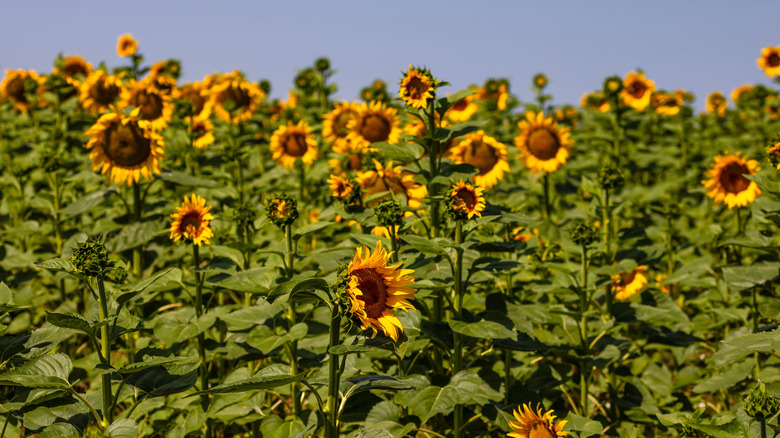How Long Do Sunflowers Really Take To Grow?
Few flowers capture the essence of summer quite like the sunflower (Helianthus annuus). With their towering stalks, golden petals, and sunny disposition — literally, thanks to their habit of turning toward the light, or heliotropism — sunflowers bring instant cheer to garden beds, borders, and backyard plots. It's no wonder they are one of the most popular flowers across the whole country. Whether you're growing them for their beauty, their seeds, or just to add a little sunshine to your outdoor space, one question you might want to know the answer to is: how long do sunflowers take to grow?
The answer depends on a few factors, including variety and growing conditions, but even the tallest sunflowers follow a fairly predictable timeline from seed to bloom. And the good news? You won't have to wait all season to enjoy their bright, joyful faces. On average, sunflowers take between 70 to 120 days from the time you sow the seeds to reach full bloom. The exact number depends on the variety, growing conditions, and whether you're aiming for towering giants or compact border plants. For example, smaller ornamental varieties can flower even earlier, some in just 55 days, while larger sunflowers can take closer to 95 days to bloom.
Factors that can influence a sunflower's growth
Several factors can influence how quickly your sunflowers go from seed to bloom, but temperature is one of the biggest players. Sunflowers are true warm-weather lovers. They thrive in full sun (naturally) and perform best when planted in soil that's warmed to at least 50 degrees Fahrenheit. At that temperature, seeds generally germinate within seven to 10 days. Cooler soil, on the other hand, can significantly slow the process and may lead to delayed germination.
Beyond temperature, soil conditions play a major role. Not planting sunflowers in well-drained soil is one of those avoidable mistakes everyone makes with growing sunflowers. Sunflowers prefer well-drained soil, as poorly-drained soils can hinder taproot growth. Other factors influencing the speed of sunflower growth include water and light availability, as well as daylight length. Luckily, sunflowers are still the perfect plant for beginner gardeners — give your sunflowers plenty of sun, good soil, and room for their roots to grow, and they'll reward you with strong, speedy growth.
When and how to plant sunflowers for summer blooms
If you want to enjoy those big, bright, golden blooms right in the middle of summer, then timing when you plant sunflowers is key. The best time of year to plant sunflower seeds is in late spring, after the last frost has passed and when soil temperatures have warmed. This is typically from between mid-March to mid-June, depending on where you live. This planting schedule gives your sunflowers enough time to sprout, grow, and bloom before the end of the season.
Sunflower seeds can be directly sown into your flowerbeds; in fact, they grow better when directly sown rather than started indoors. To plant your sunflower seeds, choose a sun-drenched spot that receives at least six hours of direct sunlight per day. Sow the seeds about 1 inch deep and 6 inches apart, or closer to 24 inches apart to allow giant varieties room to mature. Sunflowers appreciate consistent moisture, especially during the earlier growing stages, to help them establish strong roots. Once mature, sunflowers are drought-tolerant, but deep waterings during dry spells will help them maintain healthy stems and vibrant blooms.
With the right timing and a little patience, sunflowers are one of the most rewarding garden additions you can grow. Better yet, they can go from seed to bloom in just a few months, making them a perfect pick for gardeners who love quick, dramatic results.


